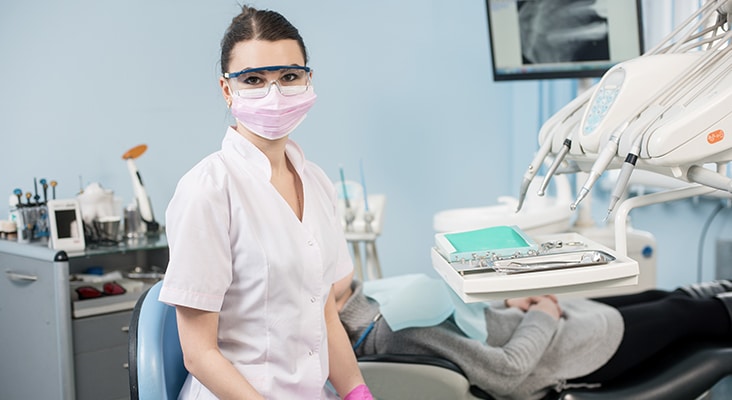Ensure an Esthetic Smile
Patients often ask their dental hygienists how to obtain a more esthetic or beautiful smile.

Patients often ask their dental hygienists how to obtain a more esthetic or beautiful smile. Usually, patients are searching for the latest and greatest whitening procedure; however, some patients are concerned about the appearance of their gingiva. Patients may express concern regarding the esthetic appearance of their gingiva for various reasons including the color, shape, and proportion in relation to teeth, size, and location. To address these issues, dental hygienists should understand the causes of gingival overgrowth as well as treatment options, so they can integrate gingival esthetics into their comprehensive provision of care.
Photo Credit: MStudioImages / E+

Gingival Overgrowth
A basic understanding of the gingival tissue characteristics and terminology used to describe gingival overgrowth is necessary to discuss the underlying causes. Gingival overgrowth, typically called enlargement, is an abnormal increase in the size of gingiva. There are two reasons for gingival enlargement:
- Increase in the number of cells (hyperplasia)
- Increase in the size of the cell(s) (hypertrophy)
These terms are used interchangeably because enlargement is often a combination of both hyperplasia and hypertrophy with different degrees of inflammation. The only way to know definitively is via biopsy.1 Clinical presentation of gingival overgrowth may be localized or generalized, and may be slight—occupying only the interdental papilla—to severe—covering the middle to incisal third or the majority of the clinical crown of the tooth/teeth.
Photo Credit: powerofforever / iStock / Getty Images Plus

Etiology
There are four main categories of gingival overgrowth: inflammatory, drug-induced, hereditary fibromatosis, and systemic. Inflammatory gingival overgrowth can be caused by poor oral hygiene. One factor that may impact oral hygiene is malocclusion, which is commonly treated with fixed orthodontic appliances. Evidence demonstrates orthodontic appliances can hinder proper oral hygiene due to the length of therapy, patient attributes and compliance, and complexity of treatment. Some literature suggests the mechanical stress caused by orthodontic movement may be partially to blame for the inflammation. These combined factors can cause inflammatory gingival overgrowth. Many cases occur in conjunction with orthodontic treatment due to the combination of poor oral hygiene compliance and the treatment process itself. Gingiva affected by inflammatory gingival overgrowth may be red, edematous, painful, spongy, and bleed easily.
Photo Credit: wagnerokasaki / E+

Treatment Plan
Comprehensive care must begin with a thorough evaluation, which sets the stage for the clinician-patient relationship. Throughout the dental hygiene appointment, the dental hygienist gathers data which are used to create an individualized treatment plan. These assessments include a complete health and dental history, as well as clinical evaluations. A comprehensive medical history is essential as it may tie directly to the clinical examination. An important component of dental hygiene practice is to identify and treat diseases of the periodontium. As such, dental hygienists must perform a thorough periodontal evaluation, which includes assessment and documentation of probing depths, bleeding on probing, suppuration, clinical attachment level, gingival recession, furcation involvement, mobility, and plaque score.
Photo Credit: Roman Bykhalets / iStock / Getty Images Plus

Dental Hygienist’s Role
The dental hygienist is on the frontline of treating gingival overgrowth. In addition to nonsurgical periodontal therapy, patients should receive education in how to care for their oral health. Because all gingival overgrowth can be exacerbated by plaque biofilm, good oral hygiene instruction is critical for the removal of bacterial pathogens. Thompson et al recommends the Bass method of toothbrushing as more effective in plaque removal than other methods when working with a patient who has gingival overgrowth. The authors also cautioned that flossing needs to be carefully performed or the patient may cause excision or floss cuts to the adjacent papillary tissue. The patient should be involved in creating the self-care regimen to increase compliance.
Photo Credit: anatoliy_gleb / iStock / Getty Images Plus

Surgery Is a Possibility
Moffitt et al stated, “Indications for surgical treatment of drug-induced gingival enlargement include failure of nonsurgical treatment, esthetic considerations, and soft tissue impaction of erupted teeth.” When gingival overgrowth covers the clinical crown, surgical excision of the tissue is required to improve esthetics and to prevent further periodontal destruction. Surgery may be necessary to decrease probing depths to assist the patient and dental hygienist in maintaining the health of the periodontium.

